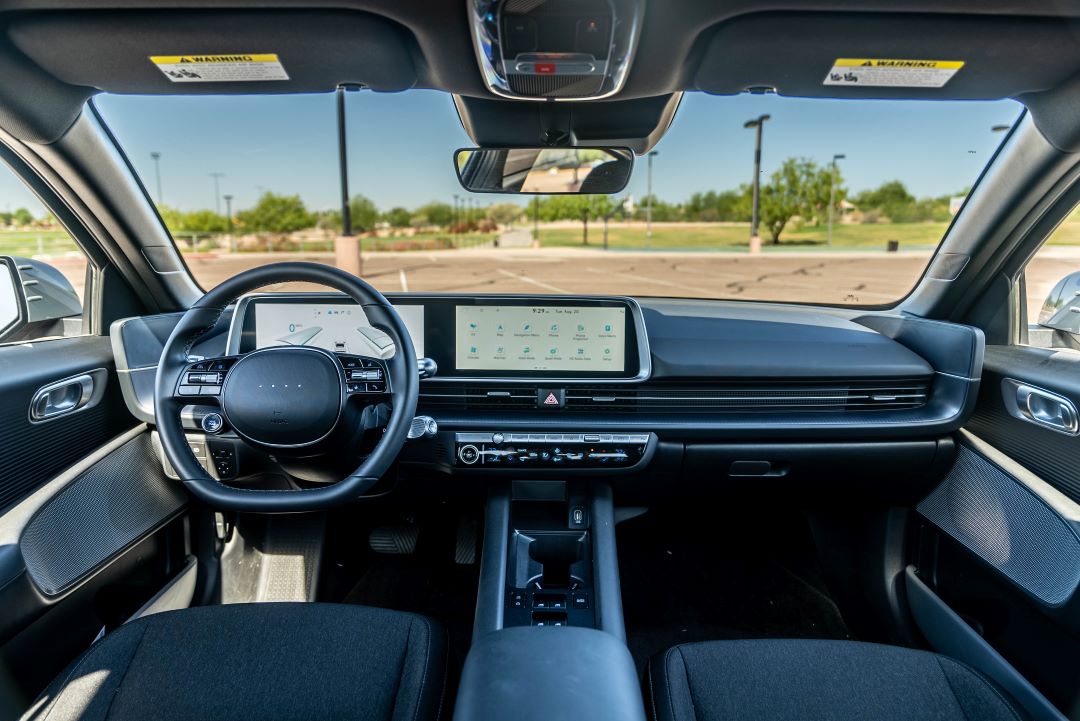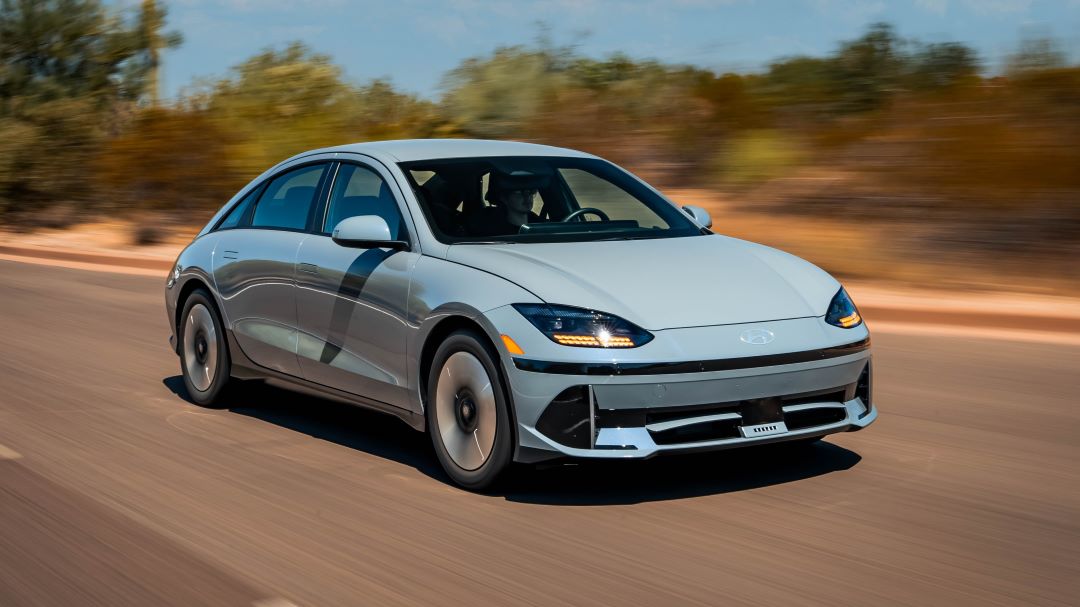There are certain vehicles on the road that are impressive simply because they exist. The awkwardly shaped, stainless steel Tesla Cybertruck is one of them. It was released almost a year ago and it’s still amazing that multiple people agreed to put something so visually radical into production. The Hyundai Ioniq 6 is another vehicle like that. It came to market as an all-electric sedan (well after other companies had abandoned the body style) with brave, all-in styling. Hyundai could’ve played things safe and put yet another crossover into a crowded segment, but they took a chance and released something unusual. Whether or not Hyundai meant to, they also normalized the EV in a major way.
PRICING AND TRIM LEVELS
Given that the Ioniq 6 came out as a 2023 model, there have been no major changes to the 2024 version. Prices start at $37,500 for a model range that includes the SE Standard Range that can go 240 miles on a full charge, SE, SEL, and top-of-the-line Limited. Except for the rear-wheel-drive-only SE Standard Range, all trim levels are available with dual-motor HTRAC all-wheel drive. Our rear-wheel-drive SE test car came standard with features such as LED headlights and taillights, 18-inch wheels, and 12.3-inch digital gauge and infotainment screens. Adding carpeted floor mats raised the final price to $43,810.
Our press loaner’s 77.4-kWh lithium-ion battery pack was connected to a single electric motor that generated 225 horsepower and 258 lb-ft of torque. Under ideal circumstances, that combination was capable of achieving 153 MPGe (miles per gallon of gasoline-equivalent) in the city, 127 on the highway, and 140 combined, and traveling 361 miles on a full charge. Charging the battery up to 80 percent can take as long as six hours and 55 minutes using an AC Level II plug or be as short as 18 minutes, if you find a 350+-kilowatt station. A 50-kilowatt charging session falls closer to the beginning of that spectrum and takes 73 minutes.
We received our Transmission Blue Ioniq 6 with 87 percent of the battery power left and a projected range of 216 miles. By the time our initial two days and nights of mixed city and highway driving were done, adding 166 miles to the odometer, the digital gauge cluster showed the battery had gone down to 28 percent and a range of 83 miles. We had averaged 3.7 miles per kilowatt-hour – lower than the 24 kilowatt-hours per 100 miles (4.17) quoted on the window sticker.
STYLING
There are so many Tesla Model 3s out on the road that you can pass five on your way to work and they will not even register. However, you’ll remember an Ioniq 6 after you pass it because it doesn’t look like anything else on the road. Influenced by the Stout Scarab of the 1930s and equipped with grids of LED lights and wheels straight out of sci-fi, it’s both retro and futuristic at the same time, as if it were a car made for a 1980s movie set in the year 2264.

INTERIOR
Doing things differently is great if it makes those things better. Tech for the sake of tech or sleek, minimalist design can – as shown in certain modern cars – break something that didn’t need fixing. Hyundai’s bold exterior design may not be for everyone, but it doesn’t get in the way of its basic function. If only that were true for our test car’s black fabric interior, which felt awkward and foreign in various ways. It started with the window switches, which were unexpectedly mounted on the center console, as they are in a Jeep Wrangler. In an email, Chris Paukert, Hyundai Motor America’s Senior Group Manager, Product Public Relations, explained the thinking behind that choice, saying, “The decision to move IONIQ 6’s windows switches to the center console was a design choice made to maximize space. By moving the controls in between driver and passenger, IONIQ 6’s long, flowing armrests could be made slimmer while still retaining their functionality as both comfortable elbow landing spots and full-length door pulls.”

Instead of mounting the 12.3-inch screens for the digital gauge cluster and the infotainment/navigation system separately, Hyundai placed them both in one wide continuous housing. While that gave the unit a certain dramatic simplicity, putting both displays on the same plane resulted in me having to stretch to reach the infotainment touchscreen and input commands.
The HVAC system was equally frustrating, an array of touch controls that made casually adjusting the temperature or fan split without looking down at them and checking finger placement impossible. There’s a reason why physical buttons and dials have lasted so long: you can use them quickly and effortlessly. Just push or grip and rip.
In other ways, the Ioniq 6’s cabin was surprisingly user-friendly. The second row offered a generous amount of legroom, especially for people under six feet tall, and the power rear hatch opened to an 11.2-cubic-foot compartment that easily swallowed one or two suitcases and a rolling duffel bag for an out-of-state trip.
ON THE ROAD
One of the most notable and appealing things about EVs seems to be the acceleration. The combination of a one-speed transmission and 100 percent of the torque being available at 0 rpm can be startling to some people at first – and addictive to everyone after that.

Like other EVs, the Ioniq 6 accelerated smoothly, but it didn’t pull forward with neck-straining force. Believe it or not, that’s a good thing. Although that kind of thrust has become a signature of electric vehicles, it’s another thing that differentiates EVs from ICE vehicles. That chasm of characteristics can be alienating and daunting to traditional car buyers, which explains why certain manufacturers have implemented features that artificially make their EVs seem more like gas cars. The 6’s corporate sibling, the Ioniq 5 N, is a great example of this. Its N e-Shift function simulates an eight-speed N dual-clutch automatic while its N Active Sound+ system uses eight internal and two external speakers to produce a trio of distinct sounds so you can “hear your ride while you drive it.” The Ioniq 6 didn’t go that far in trying to imitate an ICE vehicle, but its modest acceleration made it feel more like one, putting one small plank in the bridge over the current automotive divide.
Time will tell if that unexpected trait helps make the Ioniq 6 appealing enough to the right amount of buyers. Meanwhile, we can appreciate the fact that Hyundai was driven and passionate enough to put something so distinctive and unlikely on the road.

Comments are closed